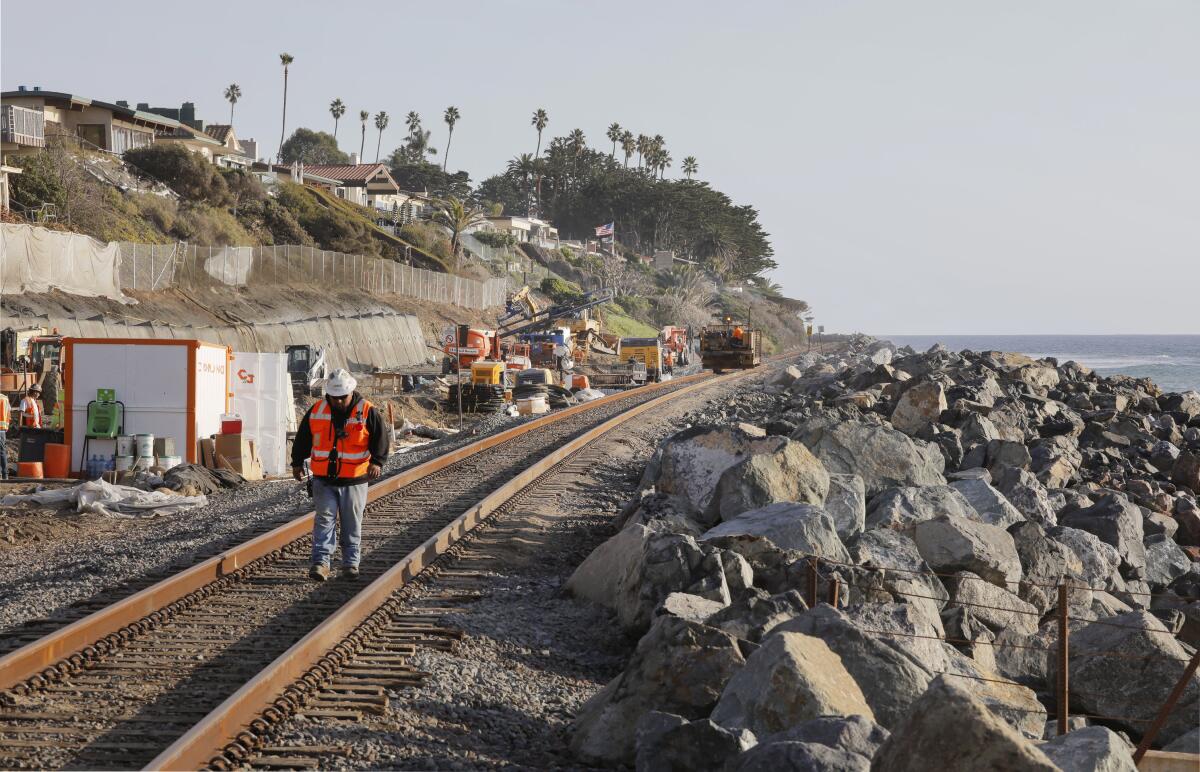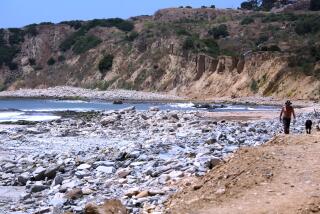Orange County looks for solution to San Clemente rail hazards

Orange County proposes extending rock revetment to protect tracks along seven miles of San Clemente beach.
- Share via
SAN DIEGO — Orange County transit officials have proposed adding more boulder seawalls to better protect what is the only railroad link to San Diego along seven miles of the coast between San Clemente and Dana Point.
A map presented at the last California Coastal Commission meeting showed new sections of rock revetment to be installed in several places along the rail corridor, including areas near the San Clemente pier and at the San Diego County border just north of Trestles Beach.
Orange County Transportation Authority officials are working with the Coastal Commission to better identify the most vulnerable areas and obtain permits for the new or expanded seawalls, OCTA project manager Jason Lee told the commission.
His remarks came during an update he presented at the commission’s Dec. 14 meeting on efforts underway to stabilize a recurring landslide in San Clemente, where passenger rail service has been suspended since Sept. 30.
The agency has fortified the rock revetment along the beach with more boulders and is installing ground anchors there to stabilize the slope on the shore side of the tracks. Amtrak and Metrolink passenger trains are expected to resume running between Oceanside and San Clemente after the construction is finished in late January or February, Lee said.
The work in San Clemente has been expedited by a temporary state of emergency declared by the Orange County agency, the fourth local emergency since September 2021 because of the landslide in San Clemente.
Two representatives of the Surfrider Foundation urged the Coastal Commission to take a more long-term approach to the problem.
Rick Erkeneff, vice chairman of the South Orange County Chapter of the foundation, said the emergency permits are frustrating for a number of reasons.
“They don’t allow for public comment or comprehensive alternative analysis showing the issues long-term,” Erkeneff said.
“With this Band-Aid approach of repeated emergencies we can only focus on 700 feet of track (in San Clemente),” he said. “Now they are talking about potentially armoring the entire length” of the seven miles from San Clemente to Dana Point.
Old aerial photographs show the beach was never wide in San Clemente, he said, and beach erosion has jeopardized the tracks for a long time.
“The situation in San Clemente should not be considered an emergency,” said Laura Walsh, the California policy manager for the Surfrider Foundation. “It’s a situation that has long been anticipated ... and successfully prepared for by other agencies in the region.”
The San Diego Assn. of Governments has been working for years on a plan to reroute the railroad around a 1.7-mile section of the tracks on the fragile coastal bluffs in Del Mar. But even after two decades of preliminary planning, the Del Mar realignment is unlikely to be completed before 2035 at the earliest.
Seawalls, soldier piles and other stabilization work have been completed on the bluffs in Del Mar, and more is planned with the understanding that the coastal structures will be removed when the alternate route through an inland tunnel is built at a cost estimated at more than $4 billion.
Surfrider has advocated for rerouting the San Clemente segment of the tracks, but so far the Orange County agency has not identified any potential new routes. Instead, it has taken emergency measures to shore up the existing track.
“Revetments and bluff tie-backs to this extent should not be dealt with through the emergency permit process,” Walsh said.
The OCTA began studying a 25-mile segment of the rail line between Irvine and the San Diego County border in 2019 to see what improvements could be made to better prepare for storm surge, sea-level rise and other extreme weather, said Eric Carpenter, a senior communications specialist for the agency.
That study resulted in the OCTA’s Rail Infrastructure Defense Against Climate Change Plan, which was completed in January 2021. The plan recommended only relative stopgap measures such as better vegetation along the rail line and improved amenities at train stations.
The Orange County agency is developing a new feasibility study that will start late next year and take 18 to 24 months to complete at an estimated cost of between $1 million and $2 million, Carpenter said in an email Wednesday.
The new study will involve numerous local, state and federal partners working to better understand the problem and to develop solutions, which could include moving the tracks, he said.
“It will look at things such as beach erosion, sand replenishment, why soil and sediment from inland rivers may not be reaching the coast, watershed impacts and other factors to help better understand the situation,” Carpenter said.
“It’s easy to say this may be caused by climate change, but if we don’t understand the very specific causes of beach erosion, we can’t develop viable, long-term solutions,” he said.
More to Read
Sign up for Essential California
The most important California stories and recommendations in your inbox every morning.
You may occasionally receive promotional content from the Los Angeles Times.











